2016–17 North American winter
The 2016–17 North American winter refers to winter in North America as it occurred across the continent from late 2016 through early 2017. During the winter, a weak La Niña was expected to influence weather conditions across the continent. Several notable events occurred during the season, including a potent winter storm that affected the East Coast of the United States in early January, the second-largest winter tornado outbreak on record later that month, and an unusually warm February. In addition, towards the end of the season, a large cyclonic storm system that caused a large tornado outbreak, flooding, and a potent blizzard in the heart of the country. However, the most notable event of the winter was a powerful blizzard that impacted the Northeast and New England in mid-March, towards the end of the season.
| 2016–17 North American winter | |
|---|---|
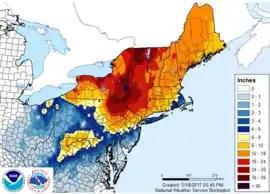 A map of snowfall totals from a major blizzard that struck the Northeastern United States on March 14–17. | |
| Seasonal boundaries | |
| Astronomical winter | December 21 – March 20 |
| Meteorological winter | December 1 – February 28 |
| Most notable event | |
| Name | March 2017 North American blizzard |
| Duration | March 11–15, 2017 |
| Maximum snow accumulation | |
| Highest snowfall total | 58 in (150 cm) (Bolton Valley, Vermont) |
| Event | March 11–15, 2017 |
While there is no well-agreed-upon date used to indicate the start of winter in the Northern Hemisphere, there are two definitions of winter which may be used. Based on the astronomical definition, winter begins at the winter solstice, which in 2016 occurred on December 21, and ends at the March equinox, which in 2017 occurred on March 20.[1] Based on the meteorological definition, the first day of winter is December 1 and the last day February 28.[2] Both definitions involve a period of approximately three months, with some variability. Winter is often defined by meteorologists to be the three calendar months with the lowest average temperatures. Since both definitions span the calendar year, it is possible to have a winter storm in two different years.
Seasonal forecasts
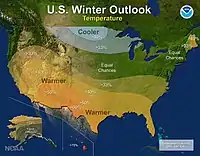
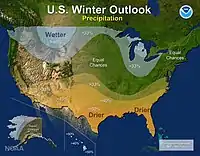
On October 20, 2016, the National Oceanic and Atmospheric Administration's Climate Prediction Center issued its U.S. Winter Outlook. A La Niña was expected to influence winter conditions, and the CPC noted that such conditions were likely to either develop in the late fall or early winter. Forecasters also noted that the La Niña, should it develop, would likely be weak and would probably be short-lived. The outlook indicated that above-average precipitation was favored in the northern Rocky Mountains, Hawaii, western Alaska, and in the vicinity of the Great Lakes. The converse was favored across the entire Southern U.S. and southern Alaska. The outlook favored above-average temperatures across the Southern United States extending through the central Rockies, in northern New England, in northern and western Alaska, and especially in Hawaii. Other regions were given "equal chances" of either above or below-average temperatures. Drought conditions were considered likely to continue in multiple regions already in drought, including parts of California and the Southwest. Such conditions were expected to not only remain but also expand in the Southeastern U.S., and development was anticipated in the southern Plains. Lessening of drought conditions was expected in northern California, western New England, parts of the Ohio Valley, the northern Plains, and the northern Rockies, while the expansion of drought conditions was considered likely in eastern New England.[3]
Events
Mid-November winter storm
In the middle part of November, a winter storm affected parts of the northern United States; it brought heavy snow to northern Minnesota and caused over 20,000 buildings to lose power in the state. Wind gusts of up to 70 mph were reported from Minnesota to Michigan.[4]
Christmas Day blizzard
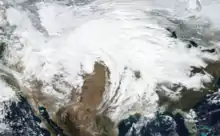
Moving ashore on the West Coast of the United States on December 23, an extratropical storm system moved through the Southwest, dumping heavy snowfall before emerging into the High Plains on December 24–25. Prior to its passage through much of the United States, it was expected to drop 1–2 feet (12–24 in) of snow, creating havoc for Christmas travelers.[5][6] The system brought the potential for severe thunderstorms as well,[7] with two tornadoes and severe winds produced across the central U.S.[8] After the cyclone moved ashore,[9] it dove southeast, weakening somewhat as it began to slowly eject into the High Plains.[10] A squall line begin to coalesce along the system's cold front as the low began to deepen somewhat. An arctic airmass to the system's north helped crank out snowfall as it slowed down in speed and continued to deepen, reaching a minimum pressure of 983 millibars (29.0 inHg) late on December 25.[11] The remaining system moved into Canada and was absorbed by another system on December 27.
Early January winter storm
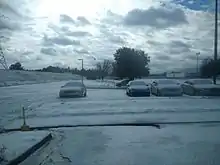
In early January, a winter storm began to impact the Southeastern United States with snow, ice and rainy conditions as it swept east, eventually moving offshore early on January 7. Afterwards, it began to track northwards and continued to produce snowfall in parts of the Carolinas and eventually the Northeast.[12]
Numerous government offices were closed in Arkansas and Oklahoma in response to the storm. On January 6, 2017, Alabama Governor Robert J. Bentley and North Carolina Governor Roy Cooper declared a state of emergency. Hartsfield-Jackson International Airport in Atlanta had a number of January 7 flights cancelled. Three people died in traffic accidents, one in Kentucky,[13] one in North Carolina[14] and another in Georgia. Eastern Virginia received as much as a foot of snow. In North Carolina, 10 inches of snow fell in Greensboro, High Point, Lewisville and Lenoir, and at one point 25,000 were without power.[15][16]
Mid-January ice storm
In mid-January, a damaging ice storm began to form which impacted the Great Plains and American Midwest.[17] On January 13, 2017, one woman from Missouri died while driving in on the icy roads, a National Football League game was postponed, and thousands lost power.[18] Sleet starting falling to the ground on January 23. Many schools had a snow day due to inclement weather on Tuesday the 24th.
Late January tornado outbreak
A strong and dangerous tornado outbreak impacted parts of the Southeast, with it being called one of the most prolific January tornado outbreaks recorded. After initially impacting the Southeast, the storm struck the Northeastern United States as a nor'easter, causing high winds, rain, snow, and ice storms. The storms caused wind damage to various buildings, including at least one death, and shuttered several airports and other transportation systems as it passed.[19][20] It also caused significant beach erosion in parts of New Jersey and flooded coastal communities in New Jersey and Long Island.[21][22] On the 24th, wind gusts around the New York City metro area approached 60 mph (97 km/h).[22]
Freezing rain and snow caused treacherous traveling conditions across southern Quebec on January 24; at least 100 accidents were blamed on slippery roads.[23]
Early February blizzard
A fast-moving but powerful blizzard affected the Northeastern United States with severe weather in the time span of February 8–9. Forming as an Alberta clipper in the northern United States, the system initially produced light snowfall from the Midwest to the Ohio Valley as it tracked southeastwards. It eventually reached the East Coast of the United States and began to rapidly grow into a powerful nor'easter. Up to 18 inches (46 cm) of snow as well as blizzard conditions were recorded in some of the hardest hit areas before the system moved away from the coastline early on February 10.
Mid-March blizzard and cold wave
A major blizzard struck the Northeastern United States around the timeframe of March 13–15, burying some places under 3–4 feet (36–48 in) of snow. The storm system resulted from the combination of two areas of low pressure that coalesced into one large system that paralleled the East Coast, bringing a widespread area of wintery weather. However, it tracked closer to the coast then expected, cutting down on snow totals in some of the big cities such as New York City, which was originally expected to receive up to 12–18 inches (30–46 cm) of snow. The nor'easter continued its way further into New England throughout the day of March 15, before subsiding the next day as it moved away from the United States.
After the blizzard, a short cold-wave hit the East U.S., while a minor snow storm hit Cape Cod on March 19, causing 1–4 inches (2.5–10.2 cm) of snow.[24][25][26][27][28][29][30]
Late April–early May storm complex
Near the end of April, a major storm system began to develop in the Rockies with heavy snowfall projected for the Plains and Upper Midwest. The storm system also brought life-threatening flooding and severe weather.
On April 28, residents in Denver, Colorado and other major cities began preparing for the storm. Officials were also worried that because of the time of year where most trees were in full bloom, the heavy wet snow might cause branches to break and fall down, possibly causing power outages.[31] In Boulder, where a golf tournament was being held, officials were prepared for possible delays to the tournament.[32] In the end, Denver picked up 5 inches (13 cm), with higher amounts in the mountains.[31] At the height of the storm, up to 9,200 were reported to be without power in Pueblo.[33]
Previously, the winter storm had dumped up to 2 feet (24 in) of snow in the higher elevations of Wyoming.[31] The state's Department of Transportation also urged residents to stay off the roadways if necessary. In addition, Highway 16 was shut down in the Bighorn Mountains because of the treacherous conditions.[34]
Blizzard warnings were issued for Kansas and the adjacent areas, as heavy snow and gusty winds were predicted.[31] After the storm subsided, about 100 evacuations and 36 rescues were reported.[35] In the northwestern part of the state, 130 miles (210 km) of Interstate 70 was shut down due to the treacherous conditions.[36][31]
References
- "Earth's Seasons: Equinoxes, Solstices, Perihelion, and Aphelion, 2000-2025" (PHP). Washington, D.C.: United States Naval Observatory. September 21, 2015. Archived from the original on August 15, 2015. Retrieved October 14, 2016.
- "Meteorological vs. Astronomical Seasons". NOAA National Centers for Environmental Information. June 21, 2013. Retrieved October 14, 2016.
- "U.S. Winter Outlook predicts warmer, drier South and cooler, wetter North: Drought expected to persist in California and expand in the Southeast". National Oceanic and Atmospheric Administration. October 20, 2016. Retrieved October 20, 2016.
- Winsor, Morgan (November 19, 2016). "First Major Winter Storm of the Season Pummels Midwest and Great Lakes Region". ABC News. Retrieved November 28, 2016.
- "Winter Storm Europa Gearing Up to Take Plains By Storm; Blizzard Conditions, Heavy Snow, Ice Likely For Christmas". weather.com. Retrieved December 25, 2016.
- "Christmas Day blizzard takes aim at the Dakotas, Montana". foxnews.com. December 25, 2016. Retrieved December 25, 2016.
- "Severe Thunderstorms Possible on Christmas Day in the Plains". weather.com. Retrieved December 25, 2016.
- "SPC Storm Reports for 12/25/16". Norman, Oklahoma: Storm Prediction Center. December 25, 2016.
- "WPC Surface Analysis Archive". noaa.gov. NOAA's National Weather Service. Retrieved December 25, 2016.
- "WPC Surface Analysis Archive". noaa.gov. NOAA's National Weather Service. Retrieved December 25, 2016.
- "WPC surface analysis valid for 12/26/2016 at 00 UTC". Weather Prediction Center. December 26, 2016.
- "Winter Storm Helena Kills 6; Cripples Travel in the South". The Weather Channel. January 8, 2017.
- McCann, Erin (January 6, 2017). "Snow and ice threatens to paralyze Southeast U.S." The Sun News. Retrieved January 7, 2017.
- O'Donnell, Lisa (January 9, 2017). "Lingering cold sends people indoors". Winston-Salem Journal. Retrieved January 9, 2017.
- Cioffi, Chris; Kane, Dan (January 7, 2017). "Winter storm brings icy conditions to Triangle roads". News & Observer. Retrieved January 7, 2017.
- Drew, Jonathan; Finley, Ben. "Snow pounds parts of East Coast, spares several big cities". The Charlotte Observer. Associated Press. Archived from the original on January 8, 2017. Retrieved January 8, 2017.
- Chaney, Eric; Carr, Ada (January 13, 2017). "Missouri Woman Dies on Icy Interstate: Winter Storm Jupiter Knocks Out Power, Glazes Roads in Plains, Midwest". The Weather Channel. Retrieved January 14, 2017.
- "One dead as ice storm targets central United States". Reuters. January 13, 2017. Retrieved January 14, 2017.
- Duff, Renee (January 23, 2017). "Storm to batter northeastern US with wind, rain and interior snow". Accuweather. Retrieved January 23, 2017.
- Breslin, Sean (January 23, 2017). "Nor'easter Hammers Mid-Atlantic, Northeast; 1 Killed in North Philadelphia". The Weather Channel. Retrieved January 23, 2017.
- Napoliello, Alex (January 24, 2017). "See Jersey Shore beach erosion damage from nor'easter". The Star-Ledger. Retrieved January 24, 2017.
- "Nor'easter Floods Streets, Topples Trees and Wreaks Havoc on Commutes". NBC 4 New York. January 24, 2017. Retrieved January 24, 2017.
- Kamila Hinkson (January 24, 2017). "Treacherous conditions across southern Quebec after freezing rain, snow". CBC News. Retrieved January 26, 2017.
- "NOAA: Mid-Day Update on on-again, off-again snow storm | CapeCodToday.com". www.capecodtoday.com. Retrieved March 20, 2017.
- "Snow to blanket the Cape and islands; Dusting expected in other parts of Massachusetts". masslive.com. Retrieved March 20, 2017.
- "Will next cold wave set stage for ice, snow in northeastern US late this week?". www.accuweather.com. Retrieved March 20, 2017.
- "Winter Storm Watch, Snow Coming Sunday". NECN. Retrieved March 20, 2017.
- Smith, Jim. "Cape Cod Withstands Another Winter Storm". Retrieved March 20, 2017.
- "Snow Spreads Through Mid-Atlantic and Cape Cod Sunday". The Weather Channel. Retrieved March 20, 2017.
- "Cold Temperatures Return Northeast". The Weather Channel. Retrieved March 20, 2017.
- "Winter Storm Ursa Dumps Snow on Higher Elevations; Denver Officials Prepare for Impacts". weather.com. Retrieved April 29, 2017.
- TEGNA. "Snow could impact Pac-12 golf championships". 9news.com. Retrieved April 29, 2017.
- [email protected], By ZACH HILLSTROM. "Late spring snowstorm causes damage, electrical outages". chieftain.com. Retrieved April 30, 2017.
- writers, Star-Tribune staff. "Storm closes roads across Wyoming". trib.com. Retrieved April 29, 2017.
- "Relentless rain swamps Missouri as Greitens declares state of emergency". kansascity.com. Retrieved April 30, 2017.
- "KAKE News on Twitter". twitter.com. Retrieved April 30, 2017.
![]() This article incorporates public domain material from websites or documents of the National Weather Service.
This article incorporates public domain material from websites or documents of the National Weather Service.
External links
- 2016 Storm Summaries from the Weather Prediction Center
- 2017 Storm Summaries from the Weather Prediction Center
| Preceded by 2015–16 |
North American winters 2016–17 |
Succeeded by 2017-18 |